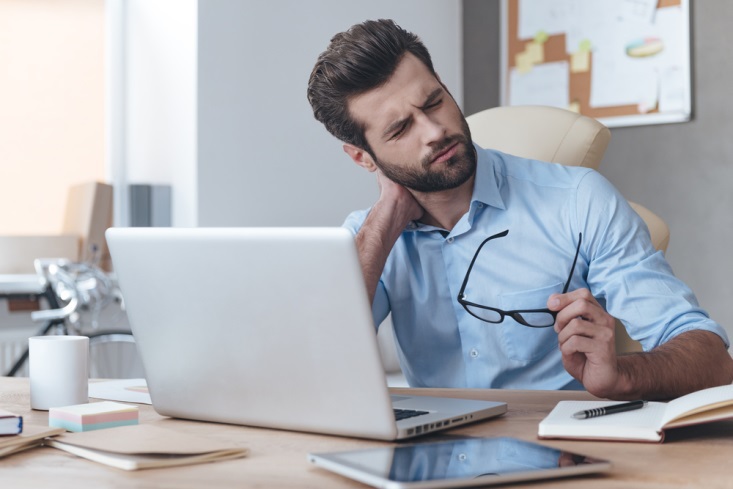Desktops, laptops, e-readers, tablets, and, of course, our phones — we spend half our lives intently staring at screens large and small. And the way most of us slouch or hunch over while we’re dealing with those devices is causing a modern epidemic of neck and back pain.
The human body is a wonderful thing but it wasn’t designed to sit in one position all day while you focus on electronic images. Your spine is a stack of small bones culminating in your neck, and spending a lot of time in an unnatural position puts pressure on these bones as well as the connecting muscles and ligaments. No wonder you hurt!
Relieving That Pain
If you’re in pain even while you’re reading this, there are a few things you can do:
Apply heat to the affected areas. Ice is for actual acute injuries with inflammation, but applying heat is the recommended method for relaxing muscles and reducing tension. The easiest and most effective way to get the soothing effect of heat is to use a microwave heating pad designed to fit your neck, shoulders, or back comfortably so it will stay in place. These can be found by shopping online, so seek them out – they might be the thing that will provide you with the relief you are seeking.
You could also try Naproxen as an over-the counter pain relief alternative.
Slow down. Don’t stop moving, but keep your movements contained.
Take an over-the-counter pain reliever. Some studies have shown that ibuprofen is better than acetaminophen in easing the pain of muscle aches, but use whichever works for you.
Stretch. Once you’re feeling a little better, do easy range-of-motion exercises. Slowly roll your neck from side to side and up and down. Squeeze your shoulder blades together and roll your shoulders backward and down a few times. Don’t overdo.
Now, maybe it’s time for a tutorial on how to use all of your miraculous electronic devices and avoid neck, shoulder, and back pain in the first place.
How to Sit in Front of a Computer
And by sit, we mean in a chair in front of a table or desk. Sprawling on the couch with the computer on a low table in front of you is a recipe for back ache. And stretching out on the floor with your laptop is no better.
- Sit with both feet on the floor. Just doing this one simple thing will discourage slouching more than crossing your legs or twisting them around the bottom of the chair.
- Adjust your chair seat and back. You want to be able to sit far back in the chair with your back supported and your knees no higher than your hips. If you have to, use a small cushion behind your lower back.
- Position your monitor. It should be about an arm’s length in front of you, and centered so that you’re looking directly at the screen with your neck in a relaxed position. The top of the monitor should be about two to three inches above your eye level.
- Position your keyboard. You shouldn’t have to stretch or twist to type on it, so make sure it’s centered in front of you and close enough so that you can use it with your shoulders relaxed and your elbows close to your body. If you’ve got a laptop, get an external keyboard so you can move and adjust it independently from the device.
- Adjust your keyboard. Tilt it so you can access it comfortably without strain on your wrists. Wrist rests help keep your hand in a neutral position, but should only be used between keystrokes and not while you’re typing.
- Sit up straight. When you’re involved in what you’re doing, you forget about your posture. Check yourself whenever you think of it, and correct your position. It may feel awkward at first, but keep at it and make sitting up straight a habit.
How to Use a Hand-Held Device
The same care has to be taken when you’re away from a desk. “Text-neck” happens when you’re constantly stretching your neck to peer down at that phone or other device in your hand. Frequent forward flexion puts extra pressure on your neck, causing tension in the upper spine and its supporting ligaments and muscles. It can cause big problems down the line, including disc herniation, pinched nerves, and even loss of lung capacity. So hold that phone at eye level!
A Note About Taking Breaks
Do it! The longer you sit, the more your muscles tense, so make a special effort to stretch your back, roll your shoulders, and resettle in your chair every thirty minutes or so. Stand up and do something else for a few minutes every hour, even if it’s just reaching up into the air, touching your toes, or walking over to look out the window for a moment. Check out these simple stretching exercises recommended by the Mayo Clinic.

